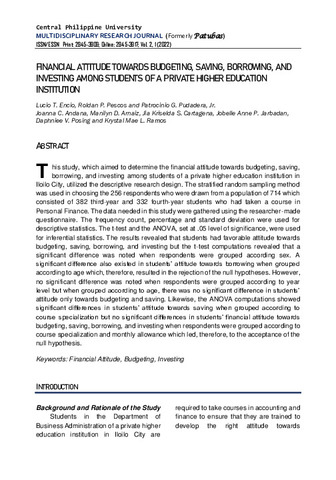Financial attitude towards budgeting, saving, borrowing, and investing among students of a private higher education institution
| dc.contributor.author | Encio, Lucio T. | |
| dc.contributor.author | Pescos, Roldan P. | |
| dc.contributor.author | Pudadera, Patrocinio G. | |
| dc.contributor.author | Andana, Joanna C. | |
| dc.contributor.author | Arnaiz, Manilyn D. | |
| dc.contributor.author | Cartagena, Jia Kriselda S. | |
| dc.contributor.author | Jarbadan, Jobelle Anne P. | |
| dc.contributor.author | Posing, Daphniee V. | |
| dc.contributor.author | Ramos, Krystal Mae L. | |
| dc.date.accessioned | 2023-06-27T02:04:49Z | |
| dc.date.available | 2023-06-27T02:04:49Z | |
| dc.date.issued | 2022-12 | |
| dc.identifier.issn | 2945-3909 | |
| dc.identifier.uri | https://hdl.handle.net/20.500.12852/2704 | |
| dc.description | Journal article | en_US |
| dc.description.abstract | This study, which aimed to determine the financial attitude towards budgeting, saving, borrowing, and investing among students of a private higher education institution in Iloilo City, utilized the descriptive research design. The stratified random sampling method was used in choosing the 256 respondents who were drawn from a population of 714 which consisted of 382 third-year and 332 fourth-year students who had taken a course in Personal Finance. The data needed in this study were gathered using the researcher-made questionnaire. The frequency count, percentage and standard deviation were used for descriptive statistics. The t-test and the ANOVA, set at .05 level of significance, were used for inferential statistics. The results revealed that students had favorable attitude towards budgeting, saving, borrowing, and investing but the t-test computations revealed that a significant difference was noted when respondents were grouped according sex. A significant difference also existed in students’ attitude towards borrowing when grouped according to age which, therefore, resulted in the rejection of the null hypotheses. However, no significant difference was noted when respondents were grouped according to year level but when grouped according to age, there was no significant difference in students’ attitude only towards budgeting and saving. Likewise, the ANOVA computations showed significant differences in students’ attitude towards saving when grouped according to course specialization but no significant differences in students’ financial attitude towards budgeting, saving, borrowing, and investing when respondents were grouped according to course specialization and monthly allowance which led, therefore, to the acceptance of the null hypothesis. | en_US |
| dc.description.sponsorship | Central Philippine University | en_US |
| dc.language.iso | en | en_US |
| dc.publisher | Central Philippine University | en_US |
| dc.subject.lcsh | Budget | en_US |
| dc.subject.lcsh | Investments | en_US |
| dc.subject.lcsh | Saving and investment | en_US |
| dc.subject.lcsh | Credit | en_US |
| dc.subject.lcsh | Loans | en_US |
| dc.subject.lcsh | College students--Attitudes | en_US |
| dc.title | Financial attitude towards budgeting, saving, borrowing, and investing among students of a private higher education institution | en_US |
| dc.type | Article | en_US |
| dcterms.accessRights | Publicly accessible | en_US |
| dc.citation.firstpage | 45 | en_US |
| dc.citation.lastpage | 66 | en_US |
| dc.citation.journaltitle | Central Philippine University Multidisciplinary Research Journal | en_US |
| dc.citation.volume | 2 | en_US |
| dc.citation.issue | 1 | en_US |
| local.subject | Financial attitude | en_US |
| local.subject | Budgeting | en_US |
| local.subject | Investing | en_US |
| dc.identifier.essn | 2945-3917 |
이 항목의 파일
This item appears in the following Collection(s)
-
Central Philippine University Multidisciplinary Research Journal [65]
Central Philippine University Multidisciplinary Research Journal (formerly Patubas) is published bi-annually under the auspices of Central Philippine University


